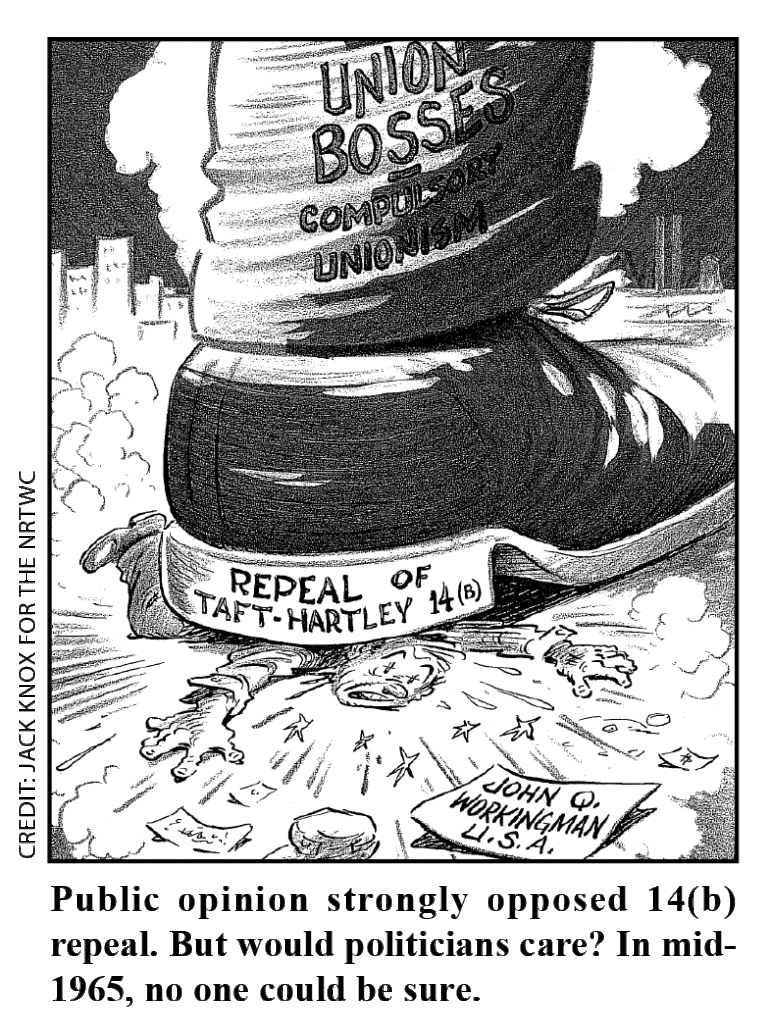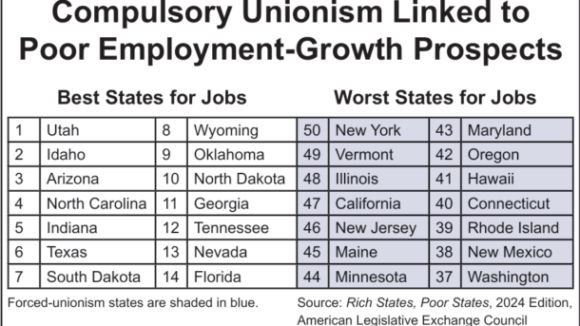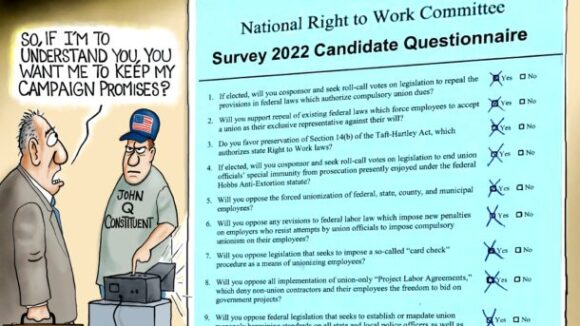Is This Any Way to Run a City’s Schools?
Leaked CTU Proposals Won’t Do Anything to Improve Schools’ Poor Performance
Scheme to Nationalize Forced Dues Was Derailed Half-a-Century Ago
(Source: May 2015 National Right to Work Newsletter)
Over the next few months, the National Right to Work Committee will be commemorating a major political battle that began in the spring of 1965. Had this battle turned out the wrong way, protections against compulsory unionism for employees nationwide would have been gutted.
Fifty years ago this month, union-label Congressman Frank Thompson (D-N.J.), chairman of the monolithically pro-union coercion U.S. House Sub-Committee on Labor, launched two weeks’ worth of hearings on H.R.77, legislation that would “repeal Section 14(b) of the Taft-Hartley Act.”
 Since Section 14(b) is the sole provision in any federal statute that explicitly authorizes states and territories to prohibit forced union membership, adoption of H.R.77 would have destroyed Right to Work protections for employees nationwide.
Since Section 14(b) is the sole provision in any federal statute that explicitly authorizes states and territories to prohibit forced union membership, adoption of H.R.77 would have destroyed Right to Work protections for employees nationwide.
‘Good Unions Don’t Need Compulsory Unionism,’ ‘Bad Unions Don’t Deserve It’
A nationwide scientific poll of the U.S. adult population, taken by the Opinion Research Corporation of Princeton, N.J., had recently shown that the American people favored retention of Section 14(b) by better than a two-to-one margin.
But National Right to Work Committee members, who were spearheading the campaign to save Section 14(b), knew from the start that persuading a majority of congressmen to vote in accord with the wishes of their constituents wouldn’t be easy.
As part of the Committee’s campaign to mobilize such intense opposition to the Big Labor power grab that Capitol Hill politicians would have to pay heed, pro-Right to Work union members from around the country joined Committee leaders in appearing before the Thompson panel on June 1, 1965.
The testimony of then-Committee President S.D. Cadwallader, himself a union member for more than 23 years, included a splendid 25-word explanation of why Section 14(b) should remain on the federal books:
“The record has shown that good unions don’t need compulsory unionism. I’m sure you gentlemen will agree with me that bad unions don’t deserve it.”
‘The Real Issue — and The Only Issue . . . Is Individual Freedom’
Reed Larson, then the Committee’s executive vice president and later its president, bluntly told pro-union monopoly politicians:
“The real issue — and the only issue — involved in the repeal of 14(b) is individual freedom; the question of whether any . . . citizen should be under compulsion to have his earnings taken from him and spent by a private organization, a union, in ways that are not to his liking. That this is being done under compulsory unionism is a matter of record.”
For more than seven weeks after Mr. Thompson abruptly cut off his hearings on June 8, sacks of letters from constituents who had been contacted by the Committee and urged to support 14(b) kept piling up in House offices. Newspapers across the country overwhelmingly opposed H.R.77.
When the bill came up for a floor vote on July 28, quite a few House members had yet to declare which way they would go, and the outcome was still, as writer George Leef explained in Free Choice for Workers, his 2005 history of the Right to Work movement, “very much in doubt.”
In the end, a furious arm-twisting campaign led by then-AFL-CIO President George Meany and his top lobbyist, Andrew Biemiller, prevailed upon 18 Democratic House members to vote to eviscerate the Right to Work laws enacted by their own states.
Their votes carried the day, as 14(b) repeal was approved by the House in a close 221-203 roll call.
Pro-Right to Work Americans were disappointed. But Mr. Cadwallader, Mr. Larson, other Right to Work officers, and rank-and-file members and supporters were already girding their loins to defeat Big Labor’s army of lobbyists in the Senate.
NEXT MONTH: Extended Senate Debate Saves State Right to Work Laws

Leaked CTU Proposals Won’t Do Anything to Improve Schools’ Poor Performance

Wherever Big Labor wields the power to collect forced union dues, union bosses funnel a large share of the confiscated money into efforts to elect and reelect business-bashing politicians. Employment growth tends to lag as a consequence.

Members Insist They Keep Pro-Right to Work Campaign Promises